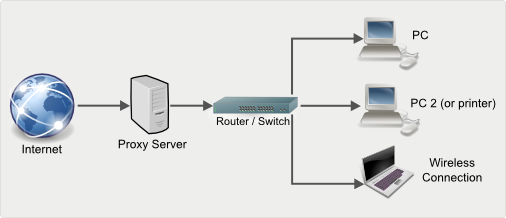How to Setup a Proxy Server
A proxy server is one that receives requests intended for another server and that acts on the behalf of the client (as the client proxy) to obtain the requested service. It is often used when the client and the server are incompatible for direct connection. For example, the client may be unable to meet the security authentication requirements of the server but may be required to access some services. It may also be used for screening purposes to enable the administrator to control access to undesirable sites. The proxy server may also be used for caching purposes, which enables faster access to frequently used websites. All the computers connected to the LAN access the Internet through a single IP address, resulting in improved security simply because the number of ports exposed is reduced.

Proxy servers work on the seventh layer (the Application Layer) of the OSI model, thus tending to be application dependent unlike firewalls that work at lower layers. They are also more difficult to install and maintain than firewalls, as proxy functions for each application protocol like HTTP, SMTP, or SOCKS must be configured individually. However, a properly configured proxy server improves network security and performance. Since proxy servers function at the OSI Application layer, their filtering capabilities are relatively intelligent. For example, proxy web servers can check the URL (Uniform Resource Locator) of outgoing requests for Web pages by inspecting HTTP, GET and POST messages. Using this feature, network administrators can bar access to illegal domains but allow access to other sites. Ordinary firewalls, in contrast, cannot see Web domain names inside those messages. Likewise, ordinary routers can filter incoming data traffic by port number or network address, but proxy servers can also filter based on application content inside the messages.
WinProxy
One of the most popular proxy servers available for Windows based systems is WinProxy. One of the reasons for its popularity is that no software has to be installed on the client systems. This is possible since WinProxy is a transparent proxy server, meaning that it also provides NAT (Network Address Translation). Due to this, the client system is virtually unaware of the proxy server’s existence. Apart from the usual caching and security features, it also supports important protocols like HTTP, Real Audio/Video, Mail, FTP, NNTP News, Telnet, Socks, Secure Sockets, DNS, IMAP 4, etc.
The WinProxy Server may be installed and configured as follows:
- Install the TCP/IP protocol on all systems connected to the network.
- Run the Install Wizard. The first screen is the product registration screen, which requires the user to enter the product key.
- The next two screens require information about the Internet connection. Select the connection’s type and name.
- Enter the username and password of the Internet connection to be used.
- WinProxy then configures the internal and external IP addresses. It automatically assigns a unique address to each device on the LAN as internal addresses. The IP address that the ISP assigns to the modem/router is taken as the external address.
- WinProxy then prompts the user to disconnect from the Internet if he/she is already connected.
- In the final step, WinProxy works through all the steps and verifies that all operations have been performed properly.


Comments - 13 Responses to “How to Setup a Proxy Server”
Sorry but comments are closed at this time.